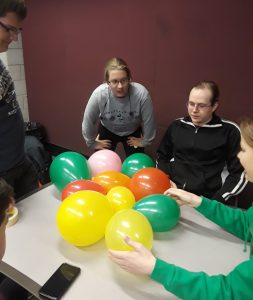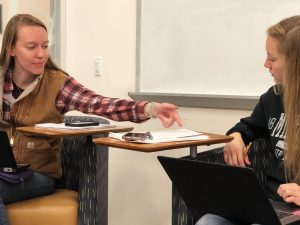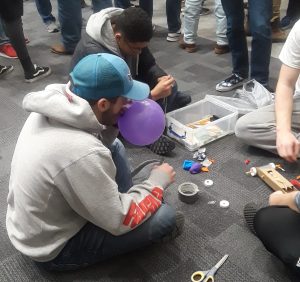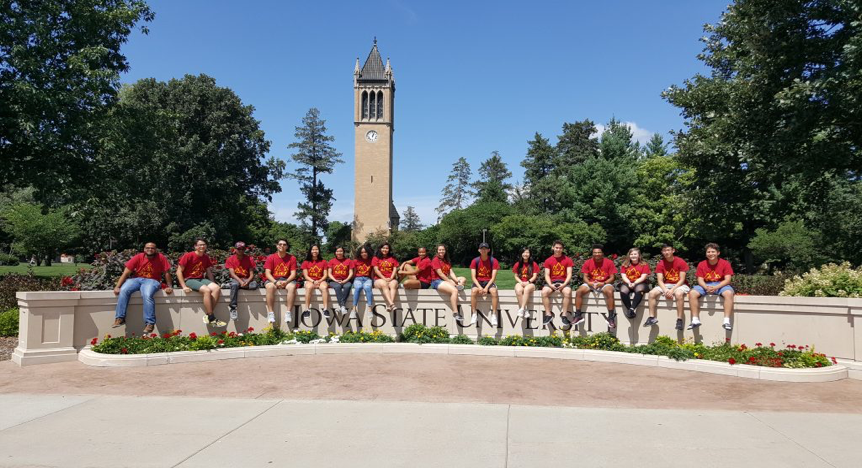Creating bonds in the classroom
“Learning communities are a great way to make a large university like Iowa State feel smaller and friendlier,” said Clayton Johnson, coordinator for Engineering Exploration learning community.
The Engineering Exploration learning community is open to first-year undeclared engineering students. This learning community aims to provide support for more than 300 first-year students each semester as they discover their engineering interests.

Every week, small sections of about 10–20 Engineering Exploration students meet in a seminar class (ENGR 131) taught by their peer mentors, like Dominique Serrano, a junior in mechanical engineering.
Peer mentors are students qualified to lead the learning communities by facilitating events, teaching classes and seminars and assisting with academic questions, among a variety of other duties and services they provide to their mentees.
“Because I was an undecided engineering major like my students are now,” said Serrano, “I felt that since I went through the same classes and experiences, I could help others get through the ups and downs of being a first-year engineering student.”
In these weekly seminars, students learn team building skills through hands-on, collaborative design experiences. In one seminar, students worked in teams to create a chair from balloons and masking tape that would be able to support the weight of a student for a minimum of five minutes.
Activities such as this teach students to be creative when working with less than ideal materials, to involve each team member’s ideas and contributions and to build connections between members.
Casey Downing, a freshman engineering student, recommends joining a learning community to other students to make the transition to Iowa State smoother. He says it creates small groups that support each other in and out of class.
“It [the learning community] has given a group of people I see in 90 percent of my classes I can talk to and get familiar with,” said Downing.
Retaining students through relationship-building

In the fall of 1997, Iowa State University’s Agricultural & Biosystems Engineering (ISU ABE) Department saw a 33% decline in retaining incoming students.
This threw a then-new associate chair of teaching into a sticky situation. Steve Mickelson needed to find the cause of the decline in retention rates. Mickelson (who today is the chair of ISU ABE) looked to successful programs on campus and saw an answer . . . peer connections.
“The goal was to make sure students completed their assignments, got answers to their questions and communicated what was going well and what wasn’t going well to experienced upperclassmen,” Mickelson says.
If he could tie challenging courses together in a low-pressure group environment, Mickelson thought he might be able to stem the flow of students leaving the department. In the next several semesters, Mickelson studied various ISU ABE courses to see which were tripping points for students. Along with advisors and faculty, Mickelson suggested that ABE 170: Engineering Graphics and Introductory Design and a freshman English course be taken in conjunction with a hands-on experience course. A student would sign up for this combination of courses with a cohort of fellow new students.
Freshman were put into groups of 4-6 people per group with one upperclassman peer mentor. Freshman and transfer students were automatically enrolled in these courses in their first year. Within two years of starting this program, the department saw a 95% retention rate for students.
Ryan Benning (2003 B.S., 2005 M.S. agricultural engineering) is a former peer mentor and is currently on the corporate engineering mechanical team for Hormell Foods.
“The program was very beneficial and it made me feel more connected to the department,” says Benning. “It was my family away from my family.”
Today, students who are involved in the peer mentor program within the department have a 7% higher chance of sticking with ISU ABE for the duration of their college career.
“We have an environment that will help you be successful and have a better chance of being successful,” Mickelson says.
Sara Weyer is a peer mentor and has been for the past two semesters. She spends time each week meeting with her group. Weyer values the learning community ties that she’s made over her time at ISU ABE.
“You are able to build connections and be more interactive with this opportunity than other programs outside of ABE,” Weyer says.
Teamwork and hands-on learning opportunities
As the largest major on campus, there are as many inspirations for studying mechanical engineering (ME) as there are mechanical engineering students.
Sophomore ME student Nick Sandeen, peer mentor for MELTS, said “I had the opportunity to restore my grandpa’s tractor, and that inspired me to become a mechanical engineer.”
The Mechanical Engineering Learning Teams (MELTS) learning community has a goal of bringing mechanical engineering students together to create a social support network with ME peers.

MELTS hosts hands-on activities and events for their students each year, including a design Olympics event that encourages collaboration, competition and communication. The design competition helps establish a sense of community within ME while improving students’ problem solving skills, teamwork skills and ability to network and connect with other students.
MELTS has organized a wide variety of design challenges over the years, including creating rubber band cars, Rube Goldberg machines, duct tape backpacks and self-propelled catapults.
This year each MELTS section competed as a “company” against the other 15 sections. Each company was split into four groups, each with their own project: a balsawood bridge group, a ping pong ball catapult group, a rubber band car group and a mini cardboard boat group.
Each group could earn points for design, cost efficiency and performance. The company that earned the most points across all groups was announced the winner of the competition.
In addition to the design Olympics event, MELTS students and peer mentors also socialize in and outside of the classroom. Ash Corpuz, a mechanical engineering freshman in peer mentor Martha Hodapp’s seminar section, cites his favorite memory as going ice skating with his ME 190 classmates.
“The more people you know and connect with, the more you’ll be able to dip your toes into,” said Corpuz.
Leadership and diversity in engineering
The Leadership through Engineering Academic Diversity (LEAD) Program provides programs and services to support the academic, professional and social success and retention of multicultural, international and women students in engineering. A signature program, the LEAD Learning Community, designed for first year and transfer students, provides the opportunity to create a community of diverse peers and make connections through engineering-related events and coursework.
LEAD provides professional and social networking opportunities, personal advising and support and acclimation support for freshmen and transfer engineering students.
Specialized programs are also available, such as the Sophomore Success Program, the Industrial Mentoring Program and a variety of collaborations with professional and Iowa State engineering clubs and organizations. The Men of Color in Engineering and the Women of Color in Engineering programs focus on the retention of students of color, building support networks through relationships on and off campus.
Iowa State also offers the Academic Program for Excellence (APEX) for multicultural first-year students seeking transition support during the summer before their first semester at Iowa State. The College of Engineering offers a track called APEX for Engineers (APEXE) that enables incoming freshmen to get a head start on college life through coursework, faculty-led research projects, industry visits and specific hands-on activities, while making lasting friendships to start the semester together.

Throughout their college experiences, engineering students have remained involved with LEAD. Previous learning community member Austin Rudolph is now a master’s student in mechanical engineering at Iowa State and recalls what drew him to pursue engineering.
“Engineering is a field that solves problems affecting our everyday lives,” said Rudolph. “These problems have no single answer and often require you to provide input in cross-functional teams to determine the best solution.”
Iowa State University offers over 90 learning communities across campus, and over 86% of first-year students participate. Since 1995, Iowa State has served over 80,000 students in learning communities.
The College of Engineering offers nearly 20 different learning communities to meet the individual needs of incoming, transfer and current engineering students in all majors.